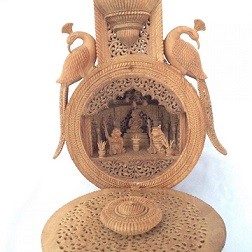- Home
- About US
- Art and Craft
- Artisans
- Master Crafts Persons
- Supporting Institutions
- News and Events
- Schemes
- Contact us
- Contact

Wood Carving is a form of woodworking by means of a cutting tool (knife) in one hand or a chisel by two hands or with one hand on a chisel and one hand on a mallet, resulting in a wooden figure or figurine, or in the sculptural ornamentation of a wooden object. The phrase may also refer to the finished product, from individual sculptures to hand-worked mouldings composing part of a tracery.The making of sculpture in wood has been extremely widely practiced but survives much less well than the other main materials such as stone and bronze, as it is vulnerable to decay, insect damage, and fire. It therefore forms an important hidden element in the art history of many cultures. Outdoor wood sculptures do not last long in most parts of the world, so that we have little idea how the totem pole tradition developed.
Wooden Carving Process-The nature of the wood being carved limits the scope of the carver in that wood is not equally strong in all directions: it is an anisotropic material. The direction in which wood is strongest is called "grain" (grain may be straight, interlocked, wavy or fiddleback, etc.). It is smart to arrange the more delicate parts of a design along the grain instead of across it. Often however a "line of best fit" is instead employed, since a design may have multiple weak points in different directions, or orientation of these along the grain would necessitate carving detail on end grain, (which is considerably more difficult). Carving blanks are also sometimes assembled, as with carousel horses, out of many smaller boards, and in this way one can orient different areas of a carving in the most logical way, both for the carving process and for durability. Less commonly, this same principle is used in solid pieces of wood, where the fork of two branches is utilized for its divergent grain, or a branch off of a larger log is carved into a beak (this was the technique employed for traditional Welsh shepherd's crooks, and some Native American adze handles). The failure to appreciate these primary rules may constantly be seen in damaged work, when it will be noticed that, whereas tendrils, tips of birds beaks, etc., arranged across the grain have been broken away, similar details designed more in harmony with the growth of the wood and not too deeply undercut remain intact.Probably the two most common woods used for carving are basswood (aka tilia or lime) and tupelo, both are hardwoods that are relatively easy to work with. Chestnut, butternut, oak, American walnut, mahogany and teak are also very good woods; while for fine work Italian walnut, sycamore maple, apple, pear, box or plum, are usually chosen. Decoration that is to be painted and of not too delicate a nature is often carved in pine.

